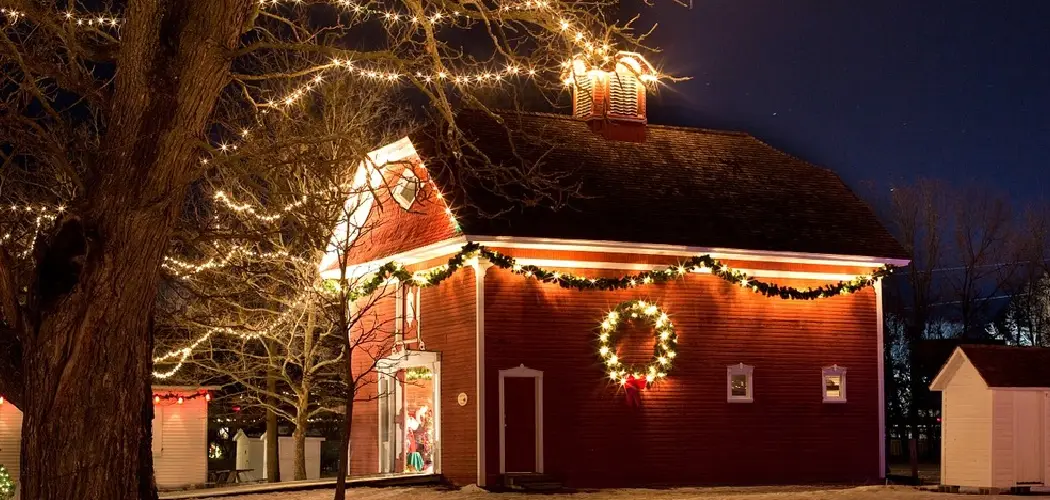Decorating with Christmas lights is a cherished tradition that brings warmth and joy to the holiday season, but rainy weather can pose significant challenges. Exposure to water and moisture can lead to short circuits, electrical damage, and even potential safety hazards such as fire risks or electric shocks. These risks not only jeopardize the functionality of your light display but may also compromise the safety of your home and family.
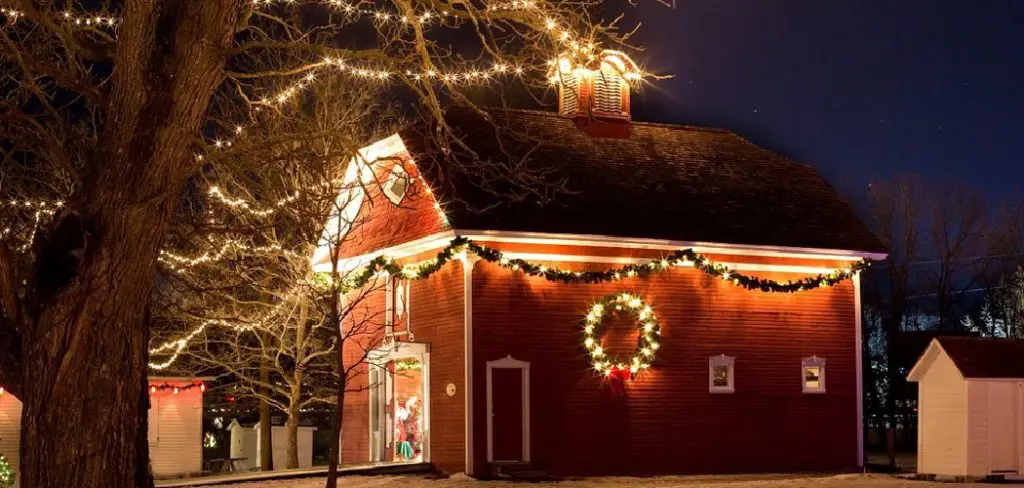
Understanding how to protect Christmas lights from rain is crucial for maintaining a bright and dazzling display throughout the season. Fortunately, there are effective strategies to shield your lights from the elements. From using weatherproof options and proper outdoor-rated installations to implementing waterproofing techniques and regular maintenance, these steps ensure your holiday decorations remain safe, long-lasting, and beautiful despite the weather. Taking these precautions allows you to enjoy a stress-free, illuminated holiday season, rain or shine.
Why Protecting Christmas Lights from Rain Is Important
Water Damage Risks
Water exposure can wreak havoc on outdoor Christmas lights, causing rust and corrosion on metal components. Rust not only diminishes the visual appeal of your light display but also weakens vital connections, reducing their structural integrity.
Additionally, prolonged exposure to moisture can lead to electrical shorts, rendering entire sections of your light display nonfunctional. This water damage significantly reduces the lifespan of your lights, forcing frequent replacements and increasing costs over time. Choosing weatherproof options and taking preventative measures can help avoid these issues, ensuring your decorations last through multiple holiday seasons.
Safety Concerns
When electrical components are exposed to rain without adequate protection, the risk of fire hazards increases substantially. Improperly installed or non-weather-rated lights can accumulate moisture in their wires and sockets, creating dangerous conditions that may result in sparking or overheating.
These hazards jeopardize your decorations’ safety and pose a serious risk to homes and families. Ensuring lights are designed for outdoor use and properly sealed against water prevents accidents and creates a secure and worry-free holiday environment.
Maintaining Functionality
Rain can cause interruptions in your light display, dampening the festive atmosphere you’ve worked hard to create. Protecting your Christmas lights from moisture damage protects you against power outages and ensures consistent functionality throughout the holiday season. A well-maintained light display brightens homes, spreads cheer, and keeps the season’s joy alive, no matter the weather.
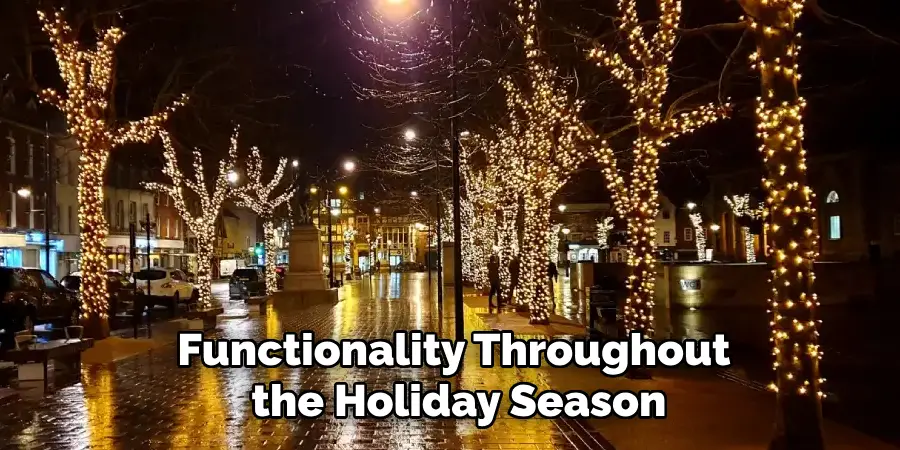
Choosing Weatherproof Christmas Lights
LED Lights for Outdoor Use
LED lights are an excellent option when selecting Christmas lights for your outdoor decorations. They are more energy-efficient than traditional incandescent bulbs, and LED lights are also highly durable and often explicitly rated for outdoor use. Their resilience in tough weather conditions makes them ideal for maintaining a bright and vibrant display, even in the face of rain or snow. Additionally, LED lights generate significantly less heat, reducing the risk of overheating and prolonging their lifespan.
IP-Rated Lights
Understanding the IP (Ingress Protection) rating is crucial when shopping for outdoor Christmas lights. The IP rating indicates a product’s protection against solid objects and moisture. For outdoor holiday lighting, an IP44 rating is the standard to look for.
This rating ensures the lights are safeguarded against rain and small particles, providing peace of mind during adverse weather. Investing in IP-rated lights is a proactive step in ensuring the safety and reliability of your decorations.
Sealed Connections
Another essential feature to consider is the presence of sealed connectors. Properly sealed connections prevent water from seeping into the wiring, reducing the risk of electrical shorts and damage.
Lights with secure, weatherproof connectors are designed to handle wet conditions, making them valuable to your outdoor display. Prioritizing lights with sealed connections is a simple yet critical measure for protecting your investments and creating a dazzling display all season long.
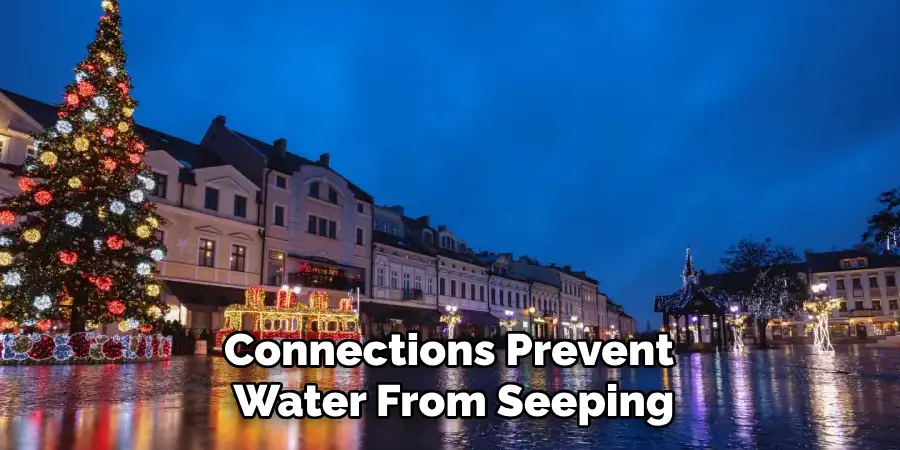
How to Protect Christmas Lights from Rain: Proper Outdoor Installation Techniques
Ensuring that your outdoor Christmas lights are installed correctly is critical for safety and durability, particularly in wet or harsh weather conditions. These proper outdoor installation techniques will help protect your decorations and home while delivering a spectacular holiday display.
Use GFCI Outlets
Always plug outdoor Christmas lights into a GFCI (Ground Fault Circuit Interrupter) outlet when installing outdoor Christmas lights. A GFCI outlet is designed to shut off electrical power immediately if it detects a ground fault, significantly reducing the risk of electrical shocks, especially in wet conditions. If your home’s outdoor outlets are not GFCI-protected, consider installing one by a licensed electrician. For added protection, you can also use portable GFCI adapters to safeguard your outdoor lighting setup.
Elevate Lights and Cords
Elevating your lights and cords off the ground is essential to minimize the danger of water damage. Hanging Christmas lights at a higher position enhances their visibility and keeps them away from standing water or puddles that can form after rain or snow. Similarly, extension cords should be routed above ground by securing them to walls, posts, or other elevated structures. This precaution helps prevent water from seeping into the cords, reducing hazards like electrical shorts.
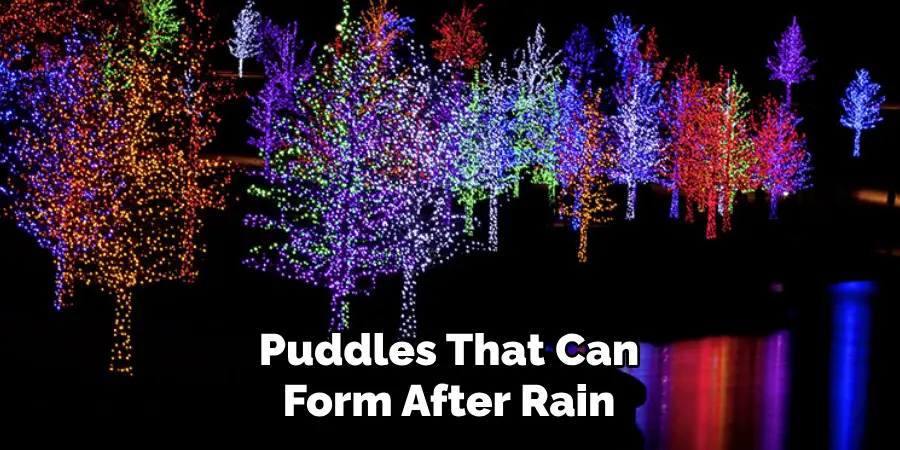
Avoid Direct Contact with Water
Carefully plan the placement of your lights and consider potential areas where water can accumulate. Avoid installing lights near gutters, which can overflow and drench your decorations. Steer clear of placing lights in areas prone to puddles or near-standing rainwater. By keeping your display away from direct water sources, you can extend the lifespan of your lights and reduce the likelihood of electrical issues.
Covering Connections with Waterproof Boxes
Protecting electrical connections is key to ensuring the overall safety of your holiday display. Use waterproof outlet boxes or specialty electrical connection covers to shield plugs and connectors from rainfall or melting snow exposure. These covers are designed to create a watertight seal while still allowing cords to pass through, offering superior protection and preventing moisture from damaging your setup.
Install Under Covered Areas
Install your Christmas lights under covered areas such as porches, awnings, or roof overhangs when possible. These areas provide natural shelter from rain and snow, reducing the chances of moisture affecting your lights. Covered installations keep your decorations dry and minimize weather-related wear and tear, ensuring they shine brightly throughout the holiday season.
Secure Wiring and Cords
Loosely hanging wires and cords can pose significant hazards during wet conditions. Always ensure that wiring and cords are securely fastened to fixed structures using clips, brackets, or zip ties. Properly securing your setup keeps everything organized, prevents accidental tripping, and helps safeguard your lights and connections from unwanted exposure to water or snow.
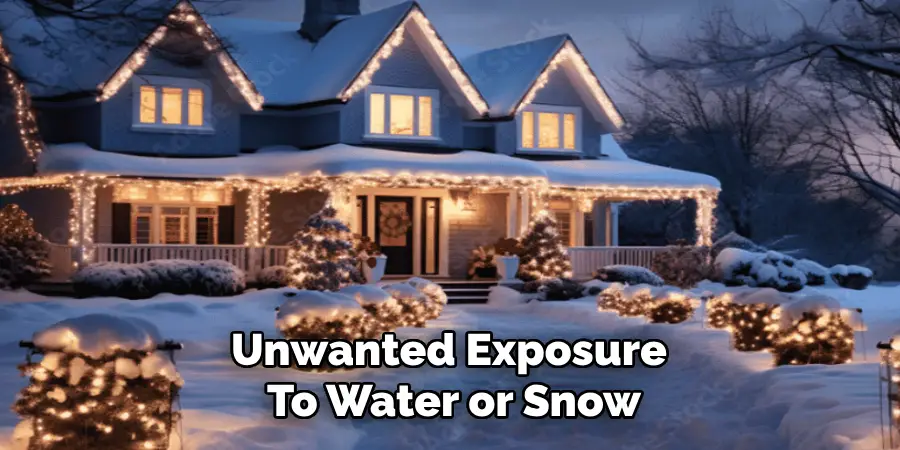
Use Outdoor-Grade Extension Cords
Finally, it’s essential to use extension cords specifically rated for outdoor use. Outdoor-grade cords are built to withstand moisture, UV light, and temperature changes, making them far more durable and reliable than indoor cords. Check for labeling that indicates an outdoor rating, and ensure the cords are in good condition with no visible wear or exposed wiring. Pairing outdoor-rated cords with quality connectors ensures a safer, long-lasting holiday lighting display.
By implementing these proper outdoor installation techniques, you can enjoy a beautiful, worry-free Christmas light display that brightens the holiday season while prioritizing safety.
How to Protect Christmas Lights from Rain: Waterproofing Techniques for Outdoor Christmas Lights
When setting up outdoor Christmas lights, making them waterproof is crucial for safety and longevity. Here are several effective waterproofing techniques to protect your display from unpredictable weather conditions:
Weatherproof Electrical Tape
Wrapping connections with weatherproof electrical tape provides an added layer of protection against rain and moisture. This durable tape creates a sealed barrier, preventing water from seeping into electrical connections and causing damage.
Plastic or Rubber Covers for Plugs
Using plastic or rubber covers for plugs is another effective way to keep your connections dry. These covers fit snugly over plug connections, shielding them from rain and snow while maintaining the integrity of your display. Ensure the covers are securely fastened for maximum protection.
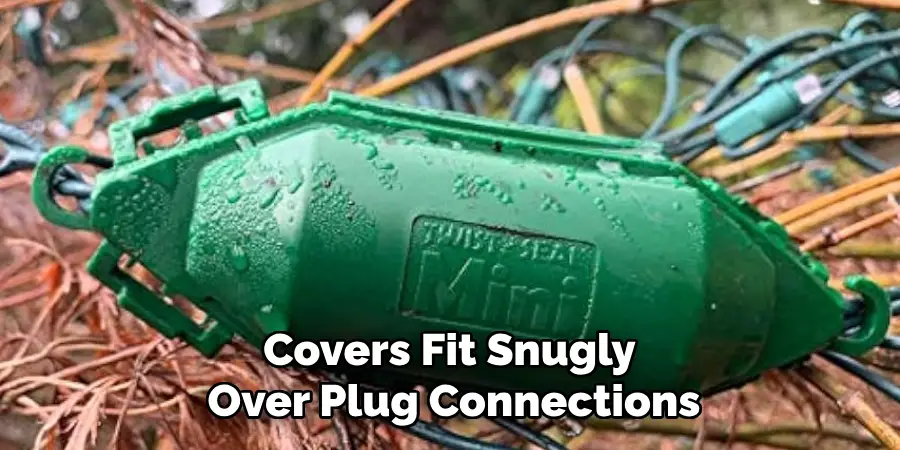
Waterproof Light Covers
Consider using waterproof light covers, such as clear plastic domes or boxes, to protect bulbs and fixtures from exposure to rain. These covers safeguard sensitive components and preserve the brightness and clarity of your lights.
Silicone Sealant for Extra Protection
For an added waterproof barrier, apply silicone sealant to areas where water might seep into connectors or fittings. This flexible sealant fills gaps and creates a strong protective layer, enhancing the durability of your light setup.
By employing these techniques, you can enjoy a safe and waterproof holiday light display throughout the season.
Timing the Lights for Weather Conditions
Monitor Weather Forecast
Regularly checking the weather forecast is crucial to safeguard your holiday light display. You can reduce the risk of damage and electrical hazards by turning off your lights during heavy rain, storms, or extreme weather. Staying ahead of adverse weather conditions helps preserve your lights’ longevity and ensures safety.
Use Timers
Timers are a convenient way to manage your lights during unfavorable weather. Set them to automatically turn off the lights during periods of anticipated heavy rain or when you’re away from home for an extended time. This not only adds a layer of protection but also ensures energy efficiency.
Consider Automatic Shutoff Features
Consider using lights equipped with built-in sensors that detect rain or moisture for enhanced safety. These automatic shutoff features help prevent water damage by disabling the lights as soon as moisture is detected, offering peace of mind throughout the season.
Troubleshooting Rain-Related Issues
Flickering or Malfunctioning Lights
If your lights start flickering or stop working after exposure to rain, begin by inspecting the connections. Ensure all plugs and sockets are secure and free from moisture. Replace any damaged bulbs to restore proper functionality. Additionally, dry out the wiring thoroughly before testing the lights again to avoid short circuits or further damage.
Wet Cords or Plugs
Wet cords or plugs can pose serious electrical hazards. If you notice any water exposure, immediately unplug the lights and carefully dry out the affected components using a towel or a safe drying method, like air circulation. For added safety, inspect the cords and plugs for visible damage and replace them if necessary to prevent future risks.
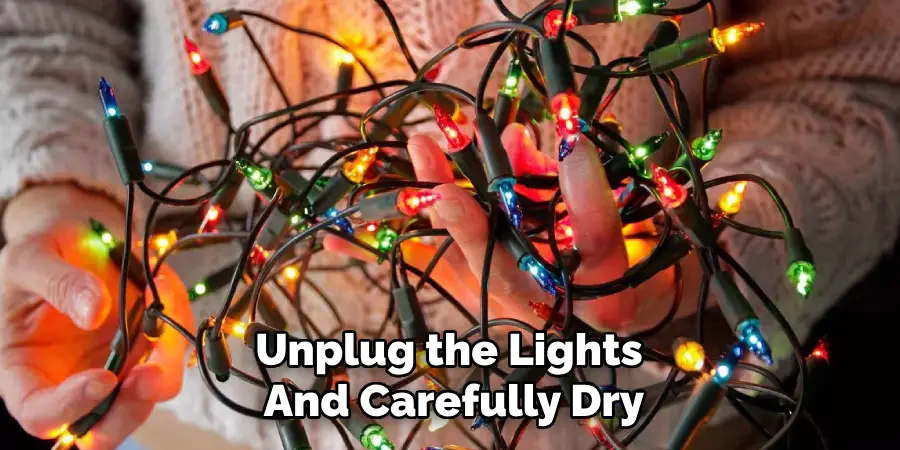
Corrosion of Metal Parts
After prolonged exposure to rain, check the metal parts of your lights, such as connectors and fasteners, for signs of rust or corrosion. Corroded components can weaken the lights and affect their performance. If corrosion is visible, replace the damaged parts promptly to maintain functionality and ensure safe operation. Regular maintenance can help extend the life of your holiday lights.
Troubleshooting Rain-Related Issues
Flickering or Malfunctioning Lights
If your lights start to flicker or stop working after exposure to rain, begin by checking all connections to ensure they are secure and free from debris. Loose or damaged connections can interrupt the flow of electricity, causing flickering or outages. Replace any damaged bulbs promptly, as one faulty bulb can affect the performance of the entire string. Additionally, inspect the wiring for dampness or damage and ensure it is scorched before testing the lights again. Use a soft cloth or a safe drying method, such as allowing the wiring to air dry, to eliminate moisture and prevent short circuits.
Wet Cords or Plugs
Wet cords or plugs require immediate attention to avoid electrical hazards. Disconnect the lights from the power source and carefully dry the cables and plugs using a towel or a safe drying technique. Damaged cords should be replaced immediately to ensure your setup’s safety. For added protection, consider using waterproof covers for outdoor connections to shield them from rain.
Corrosion of Metal Parts
Prolonged exposure to rain can lead to rust or corrosion on metal parts like connectors, fasteners, or sockets. Inspect these components regularly and check for any visible signs of deterioration. Corroded parts should be replaced promptly to maintain the integrity and functionality of your lights. Performing routine maintenance, such as applying a corrosion inhibitor, can help prolong the life and safety of your holiday lighting setup.
When to Replace Christmas Lights
Damaged Insulation or Wiring
If the insulation or wiring of your Christmas lights becomes damaged, it’s crucial to replace them immediately. Broken or frayed insulation can expose live wires, leading to potential electrical shocks, short circuits, or even fire hazards. Never attempt to repair severely damaged wiring, as it compromises the safety and reliability of your lighting setup.
Visible Corrosion
Lights with visible corrosion or rust on their metal components, such as connectors or sockets, should be replaced promptly. Corrosion can weaken the structural integrity of these parts and lead to poor electrical conductivity, which may result in malfunctioning lights or even pose a safety risk. Upgrading to lights with weather-resistant materials can help prevent such issues in the future.
Frequent Failures or Flickering
If your Christmas lights frequently fail to work correctly, flicker, or stop functioning after repeated troubleshooting efforts, it’s a sign that replacement is necessary. Persistent problems might indicate internal damage or wear that can’t be fixed effectively. Investing in new lights ensures a reliable and visually appealing display while maintaining safety.
Conclusion
Protecting your Christmas lights from rain is essential to ensure safety, functionality, and durability throughout the holiday season. You can prevent water damage and maintain a dazzling display by installing weatherproof lights properly and employing effective waterproofing techniques. Proactive measures, such as monitoring weather forecasts and promptly replacing damaged lights, further enhance the longevity and reliability of your decorations. Understanding how to protect Christmas lights from rain safeguards your holiday setup and brings peace of mind, allowing you to enjoy a festive and beautifully illuminated celebration with your loved ones.

